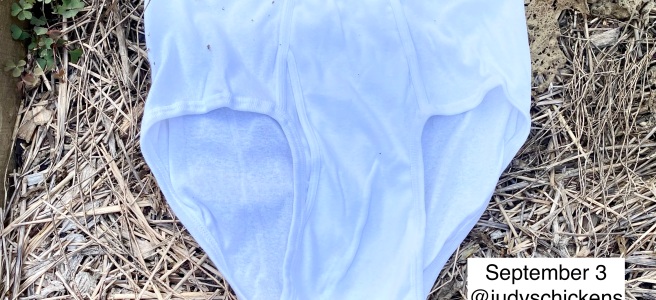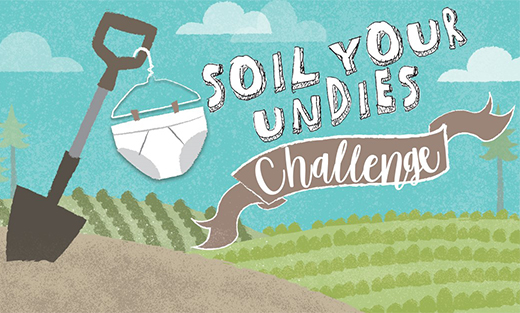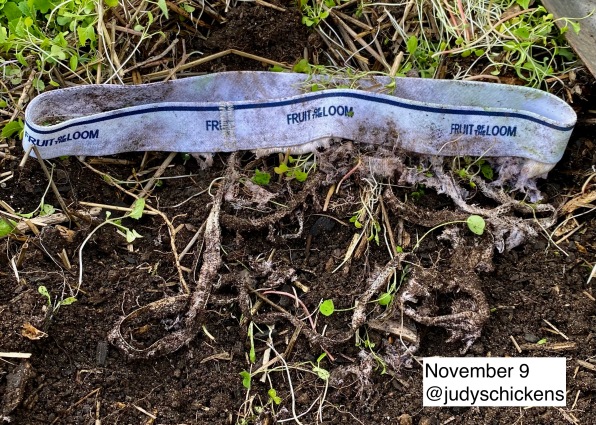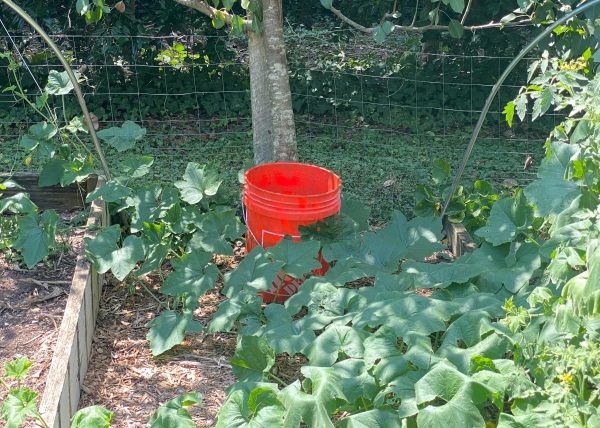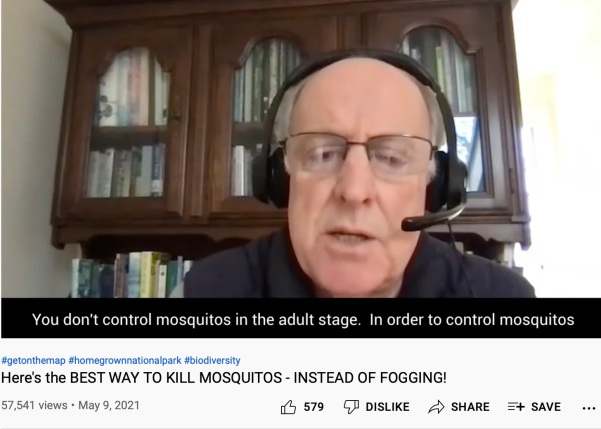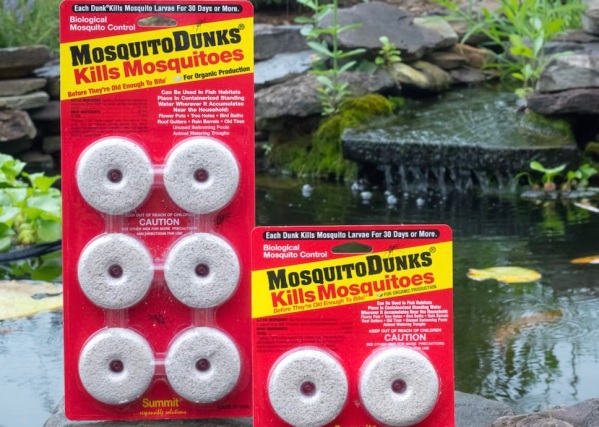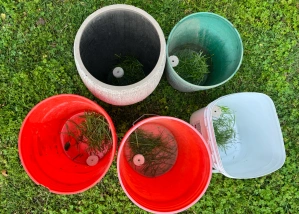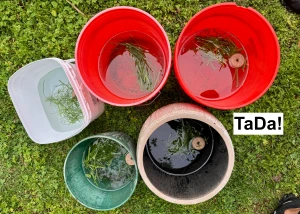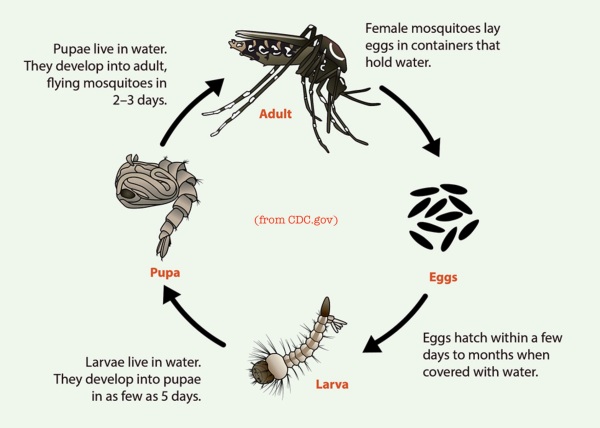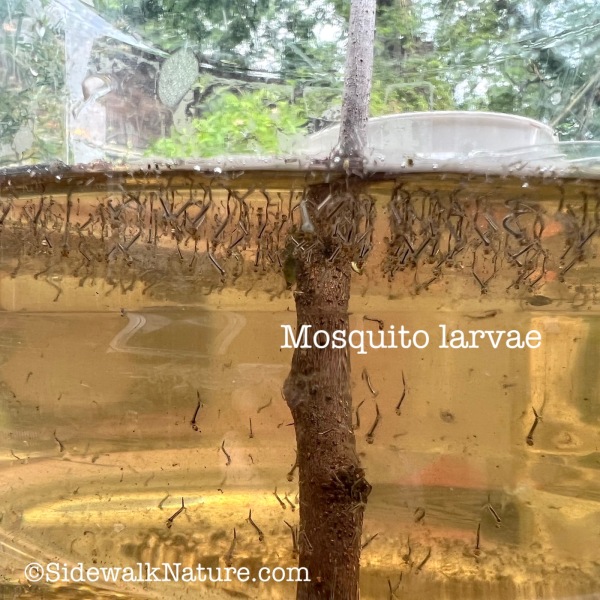A few weeks ago, I sent my grandchildren a package with two pairs of new XL men’s cotton briefs and a batch of their favorite Italian cookies. After the box arrived, their mom Facetimed so the kids could say, “Thank You.” My grandchildren, who have been gardening with me for years, asked why I had sent them such huge undies. In my most enthusiastic voice, I explained that we were going to plant them in their new garden, and it was going to be a science experiment! My six-year-old grandson brought the phone close to his face, looked me in the eye, and in a serious yet tender voice said, “YaYa, you can’t grow underwear.”
The Soil Your Undies Challenge
Last fall, I participated in a whimsical citizen science experiment called the Soil Your Undies Challenge. I “planted” new cotton briefs in one of my raised garden beds on Labor Day and “harvested” them sixty days later. The Challenge is simple: if your soil is healthy, soil-dwelling organisms will dine on the cotton until it is gone. The degree of cotton deterioration is directly related to how much microbial activity is going on. The more activity, the more “alive” and healthy your soil and the healthier your plants will be. Healthy plants resist the stress caused by drought, pests, and disease.
You can imagine my astonishment when I found the cotton had fully disappeared! Only the polycotton seams and waistband remained.
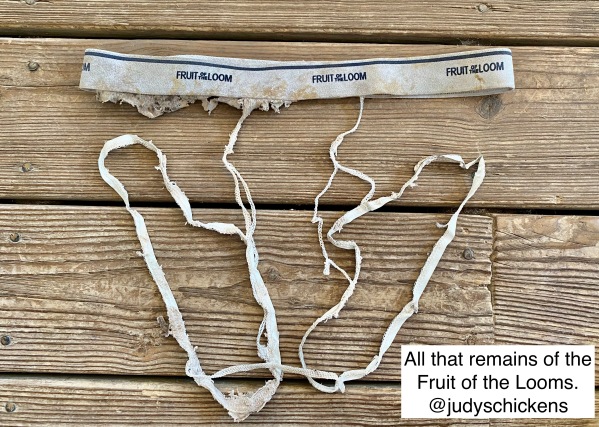
What is Soil Health?
Healthy soil is dark and crumbly, is full of nutrients, and has macroorganisms you can see like earthworms and insects, and billions of microorganisms (aka microbes) like bacteria and fungi that can only be seen under a microscope. These organisms feast on organic material like mulched leaves, grass clippings, dead plants, food scraps from the compost bucket, and sometimes buried cotton undies. Microbes rule the soil. They constantly break down organic matter creating a biological environment that allows for the absorption of nutrients by a plant’s roots. Microbial activity helps make soil porous and better able to retain water, air, and nutrients. 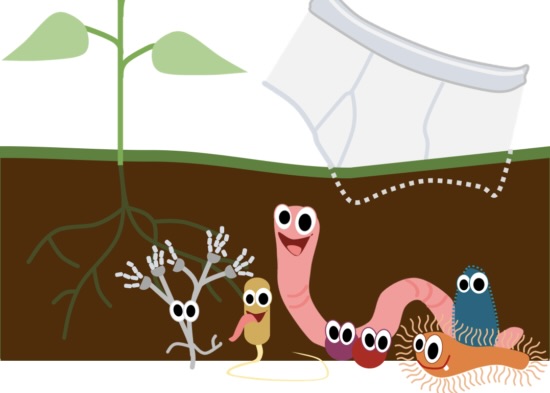
The Soil Your Undies Challenge was created by a group of Oregon farmers as a way to build public awareness of how farming practices such as tillage affect soil health. Tillage disturbs soil microbes. The no-till strategy allows organisms to do their work to create more nutrient-dense soil and keeps sequestered carbon in the ground, which is healthier for the environment. Carbon that is released into the atmosphere contributes to climate change.
Nashville’s version of the Challenge was coordinated by Jeff Barrie, CEO of the Tennessee Environmental Council, and Dr. Chris Vanags, a soil scientist in the ASCEND Initiative at Vanderbilt University. They aim to help people make informed decisions when purchasing lawn and garden products like insecticides and herbicides or when performing common land management practices like mowing a lawn perhaps too frequently or tilling a garden bed.
Methodology
For standardized data comparisons, the coordinators mailed participants the same-size briefs and a video link on how to plant them. We planted undies vertically with the waistband exposed so we could locate them two months later. We mailed before and after photos to the researchers.
Below are photos of my adorable sister-in-law, Lesley, modeling for me how to plant undies. She and my brother started their raised beds with logs, sticks, and plant debris, a type of gardening known as hugelkultur. Their soil is gorgeous.
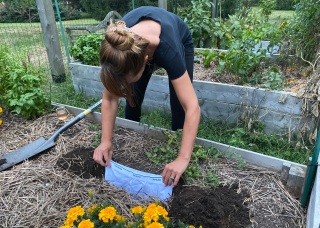
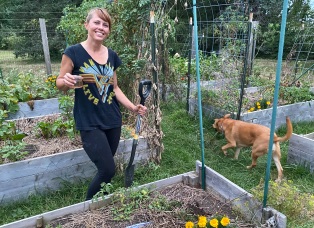
Why Use Cotton Fabric?
Cotton fibers are comprised of tens of thousands of seed hairs made of tasty carbohydrates (cellulose) that grow off of the seed coat. These hairs are present to facilitate wind dispersal of the seed for the purpose of reproduction.
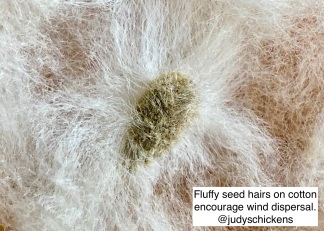

Results
One week after we unearthed the undies and sent in our photos, we met the study coordinators, Jeff and Chris, in a Facebook Live presentation. They divided the 120 “after” pictures of undies into ten categories based on the degree of degradation.
I took this screenshot of the results. It turns out my undies fell in the number ten category. I’ll admit to a momentary feeling of pride in my hard work to keep my garden beds healthy. 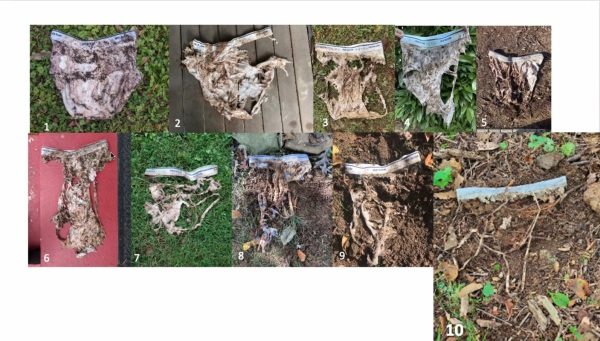
Land management practices that contribute to soil health:
Grow cover crops: Keep something growing in the garden year-round by planting cover crops between seasons. Cover crops nourish microbes and prevent soil erosion in the off-season. I plant a combination of buckwheat which suppresses weeds and whose blooms attract beneficial insects, a brassica like daikon radish or turnips whose roots drill down into the soil naturally breaking it up, and crimson clover, a legume that adds nitrogen to the ground through nitrogen fixation and whose red blossoms attract bees.
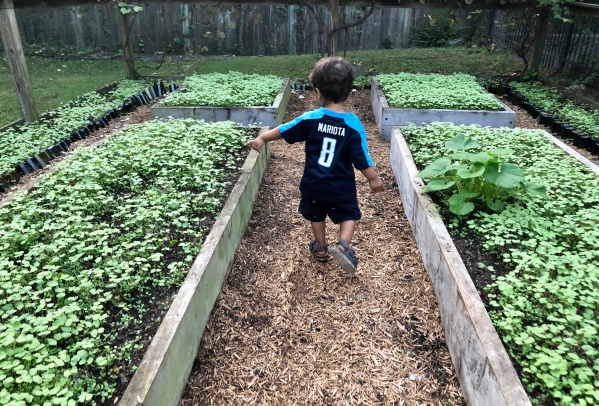
Start a compost pile. We throw food scraps, old bread and pasta, leaf litter, chicken poop, dead plants, and coffee grounds into our compost pile. We don’t add cooked food that might attract rodents. We spread composted mulch in our garden during the summer to keep moisture in and weeds out and to add nutrients to the soil,

Stop tilling in established beds. Tilling disrupts a garden’s microbial population. It exposes microorganisms to the elements where they dry out and die; it releases nutrients to rain run-off; and it releases sequestered carbon (in the form of carbon dioxide) into the atmosphere. Instead, jiggle a pitchfork or broadfork in the ground to aerate soil. I only use a tiller when creating a new bed and even then, only when the ground is too hard to break up on my own. When removing dead plants, I cut the stems at the ground level allowing the roots to decompose in situ. Check out this post to read more.
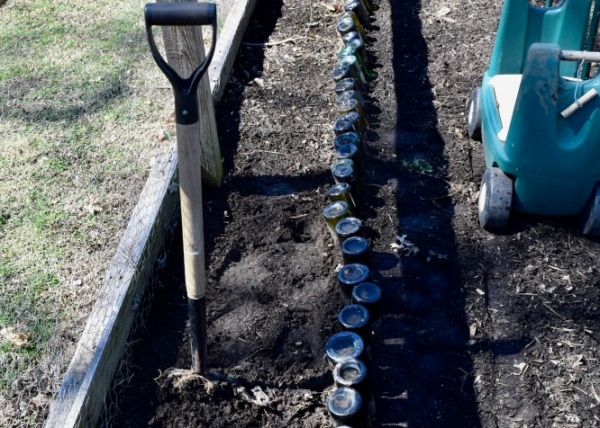
Create garden paths in your garden to discourage compaction by foot traffic. This will help keep the nooks and crannies in soil open to air and water in the garden beds. Check out How to Build a Raised Garden Bed
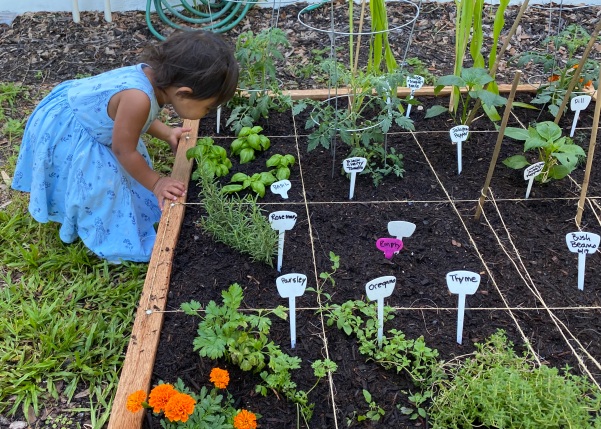
I don’t use herbicides or insecticides. I know it’s pathetic, but I only stopped using them in 2010 when I became a hen keeper — I didn’t want my free-ranging chickens to eat anything that had chemicals on it! Back then, I would joke that the chickens kept me honest.
I do not spray for mosquitos. Instead, I make mosquito bucket traps that contain a bacterium found in soil that acts as a larvacide for mosquitos.
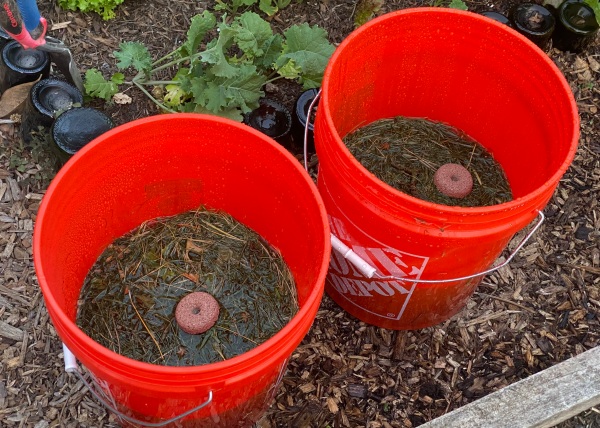
Conclusion
This study has had a profound impact on the way I think about soil. I now imagine all the microbial activity going on underground, and I am more conscious of how my chosen garden practices affect my soil. Additionally, when I give a garden tour or teach people how to start a garden, I begin with a discussion about soil health, and then I pull out my scrappy undies…
For the past year, I have volunteered at a non-profit, teaching women how to grow food. I enrolled the ladies in this year’s Soil Your Undies Challenge. They planted undies in two garden beds. As they planted the undies vertically, they quickly learned that while the topsoil was loose, the deeper soil was hard and compacted. It took a lot of work to make a slit in the ground. We’ll need to use a broadfork or pitchfork to break that soil up once the fall crops are harvested.
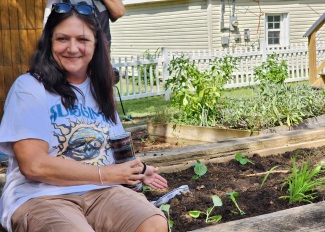
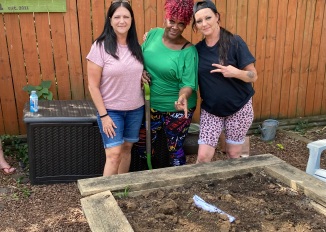
I am grateful to my friend Maureen May, founder of the Second Sunday Gardeners, who created a place for curious gardeners to come together to learn sustainable land management practices. She and another member, Heidi, encouraged twenty people in our group to participate in this study.
Related Stories:
Watch this excellent Nashville Public Television Volunteer Gardener clip: Soil Your Undies: How Healthy is Your Soil, hosted by Julie Birbiglia, the education specialist for Metro Water Services. She and Dr. Chris Vanags dig up undies on the Vanderbilt campus and discuss the results.
Julie also did two stories for NPT’s Volunteer Gardener about gardening and raising chickens in my backyard. We talked about chicken coops, what chickens eat, keeping chickens safe, composting and cover crops. One video was a Volunteer Gardener episode called Chicken Chat and the other was a FaceTime live production.
Follow Judy’s Chickens on Instagram and Pinterest @JudysChickens.
If you enjoyed this post, sign up to become a follower. If you do sign-up, press “confirm” on the follow-up letter sent to your email address. And feel free to share!!
© 2014-2022 Judy Wright. All rights reserved. Photos, videos, and text may not be reproduced without the written consent of Judy Wright.

